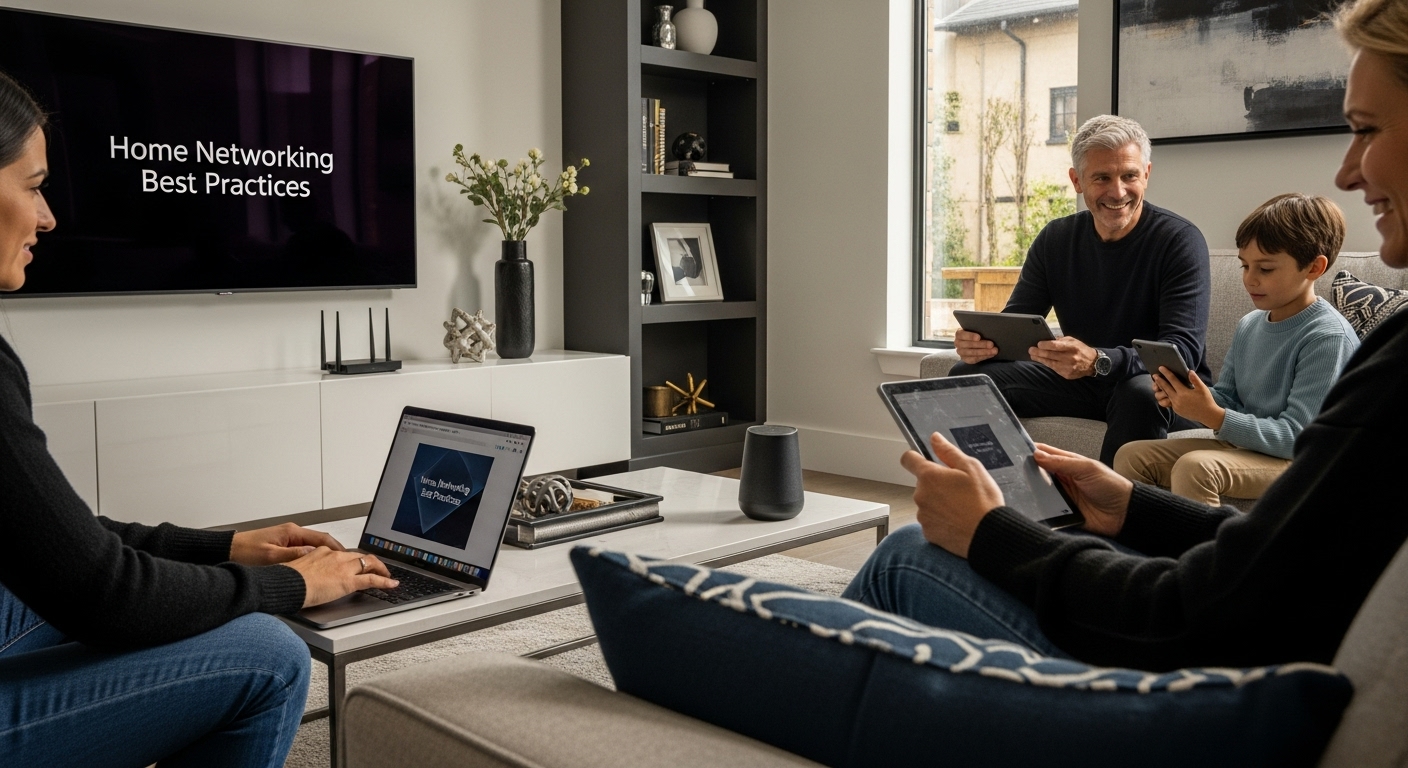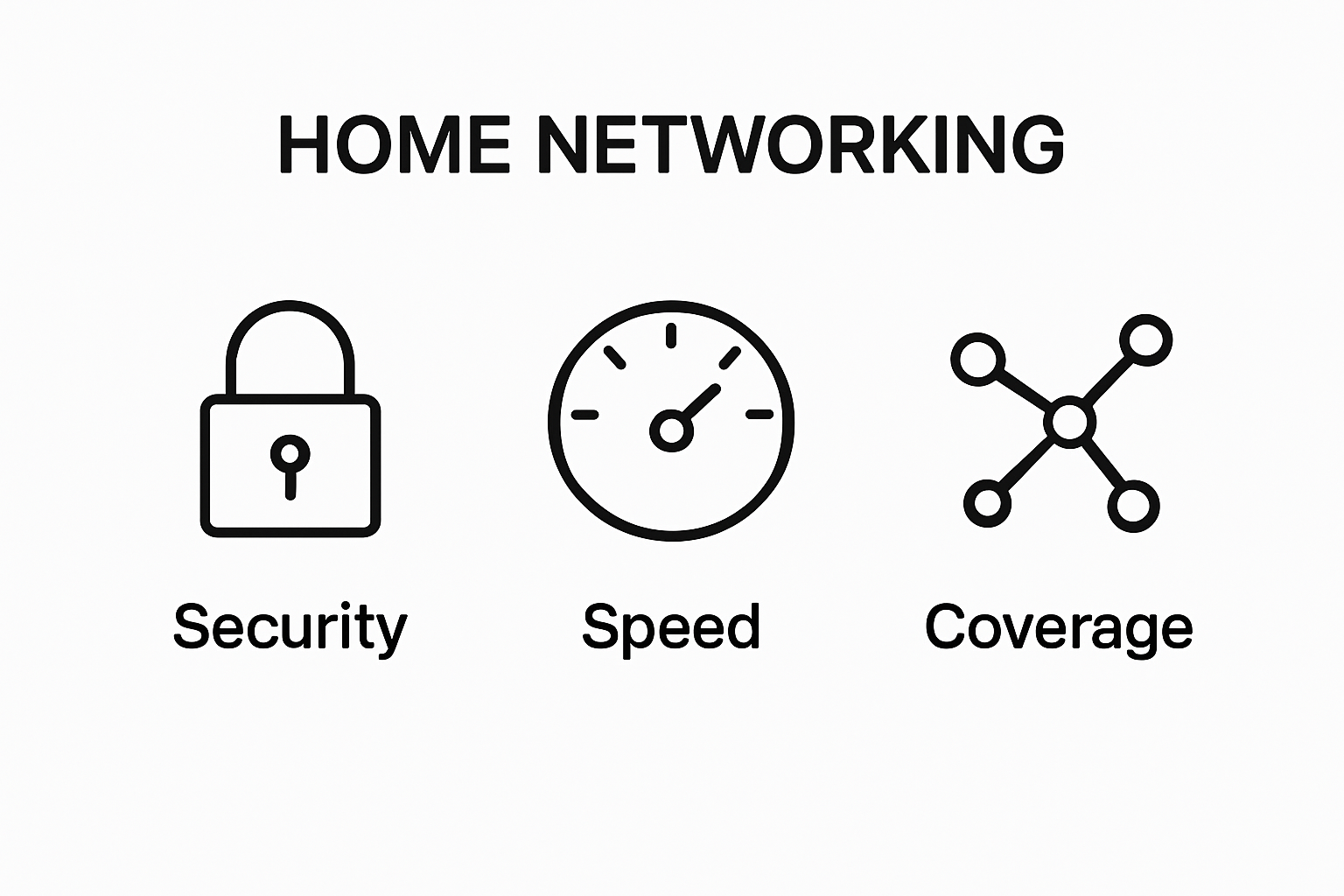Understanding Home Networking Best Practices for Luxury Living
- garygarihanjr
- Sep 14
- 9 min read

Everyone’s talking about smart gadgets, streaming, and connected living, but few realize the hidden framework powering it all: home networking. Most think it’s just Wi-Fi and a password. Surprise. The average American home now supports more than 22 connected devices at once. What’s wild is that the real challenge isn’t connecting them. It’s keeping that invisible network strong, secure, and ready for whatever comes next.
Table of Contents
Quick Summary
Takeaway | Explanation |
Home networking is essential today | Modern homes rely heavily on digital technology, making home networks crucial for daily activities. |
Robust security protocols are vital | Implement encryption, strong passwords, and network segmentation to protect against cyber threats. |
Smart devices require optimized networks | High-speed internet, low-latency connections, and bandwidth management are necessary for efficient operation of smart devices. |
Advanced technologies are shaping the future | AI and quantum networking will enhance connectivity, security, and performance in home networking systems. |
Network management tools improve performance | Utilize intelligent tools for monitoring and optimizing bandwidth, ensuring smooth communication between devices. |
What is Home Networking and Its Importance?
Home networking represents the intricate digital infrastructure connecting multiple devices within a residential environment, enabling seamless communication, data sharing, and smart technology integration. As modern homes become increasingly dependent on digital technologies, understanding home networking has transformed from a technical luxury to an essential component of contemporary living.
The Core Concept of Home Networking
At its fundamental level, home networking involves establishing a communication system that allows various electronic devices to interact and share resources through wired or wireless connections. This network typically includes smartphones, computers, smart home devices, entertainment systems, security cameras, and internet-connected appliances. The National Institute of Standards and Technology emphasizes that effective home networking goes beyond simple internet connectivity, creating an integrated ecosystem of digital interactions.
Key characteristics of a robust home network include:
Consistent and reliable internet connectivity
Secure data transmission between devices
Efficient bandwidth management
Scalable infrastructure supporting multiple devices
Why Home Networking Matters in Modern Living
Home networking has evolved from a technical convenience to a critical infrastructure supporting daily lifestyle requirements. Smart home technologies now depend on sophisticated network architectures that enable complex interactions between devices. From remotely controlling home security systems to streaming high-definition entertainment content across multiple rooms, home networking provides the backbone for these advanced functionalities.
The Federal Trade Commission highlights that modern home networks must balance performance with security. Homeowners need networks that not only support high-speed data transfer but also protect against potential cyber vulnerabilities. This means implementing robust security protocols, managing device access, and maintaining network integrity.
As residential technology continues to advance, home networking will become increasingly sophisticated, transforming how we interact with our living spaces and digital ecosystems. Understanding its principles allows homeowners to create more intelligent, responsive, and secure digital environments.
Key Components of a Home Network
A home network is more than just a collection of devices. It is a sophisticated system composed of interconnected hardware and software components that work together to facilitate seamless digital communication and data transfer. Understanding these essential elements helps homeowners design more efficient and reliable network infrastructures.
Network Hardware Foundations
The physical backbone of any home network consists of several critical hardware components. California State University, Northridge explains that these devices perform unique and complementary functions to create a robust digital ecosystem. Routers serve as the central communication hub, directing internet traffic and connecting different network segments. They translate external internet signals into local network connections, enabling multiple devices to access the internet simultaneously.
Below is a table summarizing the essential hardware components that form the backbone of a robust home network, along with a brief description of their function.
Hardware Component | Primary Function |
Router | Directs internet traffic, connects devices to the network |
Wireless Access Point | Expands wireless coverage within the home |
Network Switch | Connects multiple wired devices for local data transfer |
Ethernet/Coaxial Cable | Provides wired data transmission between network devices |
Network Interface Card | Enables devices to connect to the network (wired/wireless) |
Key network hardware includes:
Routers (primary network management device)
Wireless access points
Network switches
Ethernet and coaxial cables
Network interface controllers (NICs)
Connectivity and Data Transmission Mechanisms
Beyond physical hardware, home networks rely on sophisticated data transmission protocols and connection technologies. Wireless networks use radio frequencies to transmit data, while wired networks depend on physical cable connections. Bandwidth determines the network’s data transfer capacity, influencing the speed and quality of internet connections across multiple devices.
Modern home networks support various connectivity standards:
Wi-Fi 6 (802.11ax) for high-speed wireless connections
Gigabit Ethernet for wired high-performance links
Mesh network systems for comprehensive home coverage
Power over Ethernet (PoE) for simplified device powering
Network Security and Management Infrastructure
As home networks become more complex, integrated security and management tools have become crucial.

Firewalls, network monitoring software, and device authentication mechanisms protect against potential cyber threats. Advanced home networks now incorporate intelligent management systems that can automatically optimize performance, allocate bandwidth, and provide detailed insights into network usage.
The continuous evolution of home networking technology promises even more sophisticated, secure, and responsive digital environments for modern households.
Security Measures to Protect Your Home Network
Home network security has become a critical priority in an era of increasing digital connectivity and sophisticated cyber threats. Protecting your network is not just about preventing unauthorized access but safeguarding the entire digital ecosystem of personal and professional information that flows through your home infrastructure.
Understanding Network Vulnerability
Modern home networks represent complex digital environments with multiple potential entry points for cyber attackers. Smart devices, from internet-connected refrigerators to home security systems, can become potential vulnerability points if not properly secured. Each connected device represents a potential pathway for malicious actors seeking to exploit network weaknesses.
This table organizes the main sources of home network vulnerability and corresponding security measures discussed in the article, allowing for quick reference and comparison.
Source of Vulnerability | Security Measure to Address It |
Weak or default router passwords | Configure complex, unique passwords |
Unpatched software/firmware | Regularly update router firmware |
Unsecured wireless connections | Enable WPA3 wireless encryption |
Outdated network hardware | Replace with current, secure devices |
Lack of network segmentation | Create isolated digital zones (segments) |
Primary sources of network vulnerability include:
Weak or default router passwords
Unpatched software and firmware
Unsecured wireless connections
Outdated network hardware
Lack of network segmentation
Implementing Robust Security Protocols
The Federal Trade Commission recommends a multi-layered approach to home network protection. Network encryption forms the first line of defense, transforming data transmission into coded messages that are challenging for unauthorized parties to intercept or understand. Modern encryption standards like WPA3 provide advanced protection mechanisms that go beyond traditional security models.
Critical security measures include:
Enabling WPA3 wireless encryption
Configuring complex, unique passwords
Implementing two-factor authentication
Regularly updating router firmware
Using advanced firewall configurations
Advanced Network Protection Strategies
Beyond basic security protocols, sophisticated homeowners are adopting advanced protection strategies. Network segmentation allows creation of isolated digital zones, preventing potential breaches from spreading across the entire home network. Virtual Private Networks (VPNs) add an additional layer of anonymity and security, encrypting internet traffic and masking device identities.
Emergent technologies like artificial intelligence-powered network monitoring systems can now detect and respond to potential security threats in real-time, providing unprecedented levels of digital protection. As home networks become more complex and interconnected, proactive and intelligent security measures will become increasingly essential for maintaining digital safety.
Optimizing Your Home Network for Smart Devices
The proliferation of smart devices demands a sophisticated and adaptable home network infrastructure capable of supporting complex digital interactions. As residential technology becomes increasingly interconnected, network optimization has transformed from a technical nicety to an essential performance requirement.
Understanding Smart Device Network Requirements
Smart devices generate unprecedented data traffic, requiring networks that can manage multiple simultaneous connections with minimal latency. These interconnected technologies range from intelligent thermostats and security systems to voice-activated assistants and streaming entertainment platforms. Each device places unique demands on network bandwidth, processing capacity, and transmission protocols.
Key network considerations for smart device integration include:
Consistent high-speed internet connectivity
Low-latency transmission capabilities
Robust device management infrastructure
Scalable bandwidth allocation
Comprehensive signal coverage
Bandwidth Management and Device Prioritization
Effective smart device networking requires intelligent bandwidth allocation strategies. Modern routers with Quality of Service (QoS) features can dynamically prioritize critical network traffic, ensuring essential devices like security systems and medical monitoring equipment receive consistent, uninterrupted connectivity. Cisco Networking Experts recommend creating dedicated network segments for different device categories to optimize overall system performance.
Strategic bandwidth management techniques include:
Creating separate network segments for IoT devices
Implementing bandwidth throttling mechanisms
Using dual-band or tri-band wireless routers
Configuring device-specific transmission priorities
Monitoring real-time network performance
Advanced Network Configuration Strategies
Sophisticated homeowners are adopting advanced network architectures like mesh networking systems that provide comprehensive signal coverage and seamless device handoff capabilities. These intelligent networks automatically route traffic through the most efficient path, minimizing connection interruptions and maintaining consistent performance across large residential spaces.
The future of home networking lies in adaptive, self-optimizing systems that can anticipate and respond to changing device requirements. As smart home technologies continue evolving, network infrastructure must become increasingly intelligent, secure, and responsive to meet the complex demands of modern digital living.

Future Trends in Home Networking Technology
Home networking technology stands on the cusp of a transformative era, driven by exponential advancements in artificial intelligence, machine learning, and interconnected digital ecosystems. The future of residential networking promises unprecedented levels of intelligent automation, predictive performance, and seamless technological integration.
Emerging Technological Architectures
Artificial intelligence is poised to revolutionize home network infrastructures, enabling systems that can dynamically adapt, predict potential issues, and optimize performance in real-time. These intelligent networks will move beyond passive connectivity, becoming proactive management systems that anticipate homeowner needs and automatically resolve potential technical challenges.
Key emerging network architectural trends include:
Self-healing network infrastructures
Predictive maintenance capabilities
Automated security threat detection
Intelligent bandwidth allocation
Dynamic network segmentation
Advanced Connectivity and Performance Technologies
Maryville University highlights the growing significance of cloud networking and network automation in transforming digital infrastructure. Quantum networking represents a groundbreaking frontier, promising exponentially faster data transmission speeds and unprecedented levels of security through quantum encryption mechanisms. These technologies will enable home networks to handle increasingly complex data loads with minimal latency.
Nextgen connectivity technologies will likely feature:
6G wireless networks
Enhanced edge computing capabilities
Quantum encrypted communication channels
Integrated artificial intelligence management
Seamless multi-device synchronization
Holistic Network Ecosystem Integration
Future home networks will transcend traditional connectivity models, evolving into comprehensive digital ecosystems that integrate seamlessly across multiple domains. Smart home technologies will communicate with unprecedented sophistication, creating interconnected environments that anticipate and respond to resident behaviors and preferences.
The convergence of artificial intelligence, advanced networking technologies, and intelligent device ecosystems promises to transform residential digital experiences. Homeowners can anticipate network infrastructures that are not just responsive, but predictive intelligent, and fundamentally aligned with individual lifestyle requirements.
Discover True Luxury Networking for Smart Homes
Are you investing in smart living but worried your home network cannot keep up with advanced entertainment and automation systems? As highlighted in our article, a high-end residence demands more than just fast internet. You need seamless data sharing, robust security, and intelligent bandwidth management to turn your home into a true digital sanctuary. But achieving flawless integration and always-on connectivity can be frustrating when off-the-shelf solutions fall short. If security vulnerabilities, patchy Wi-Fi coverage, or inconsistent device performance keep you from enjoying the best tech experiences, it is time for a professional-grade upgrade.

Elevate your home’s technology today with the experts trusted by Houston’s most discerning homeowners. Visit Techology Experts to explore custom smart home networking and AV solutions tailored for luxury living. From optimizing your home network for smart devices to designing secure, scalable infrastructures for tomorrow’s innovations, our team delivers the peace of mind and sophistication you deserve. Do not let outdated systems hold back your lifestyle. Connect with us now and experience the difference of truly intelligent home automation.
Frequently Asked Questions
What is home networking?
Home networking refers to the system that connects multiple devices within a home, allowing them to communicate and share resources seamlessly. It includes devices like smartphones, computers, smart home gadgets, and entertainment systems.
Why is home networking important for luxury living?
In luxury living, home networking is crucial as it supports advanced smart home technologies, offers high-speed internet, and integrates various devices for enhanced convenience, security, and efficiency in daily living.
How can I optimize my home network for smart devices?
To optimize your home network for smart devices, ensure you have consistent high-speed internet, implement bandwidth management strategies, and use quality routers that support multiple connections and low-latency transmission.
What security measures should I take for my home network?
Implementing robust security measures for your home network includes using WPA3 encryption, configuring complex passwords, regularly updating router firmware, and utilizing firewall configurations to protect against cyber threats.
Recommended
Comments